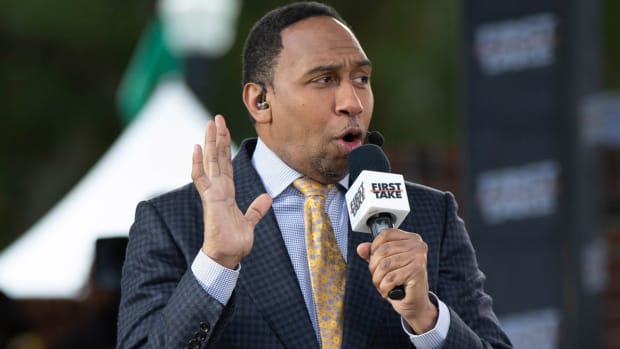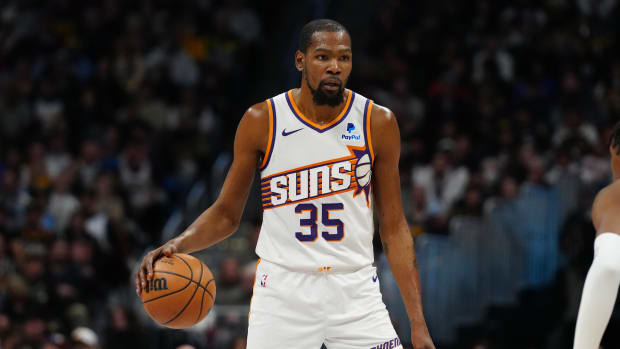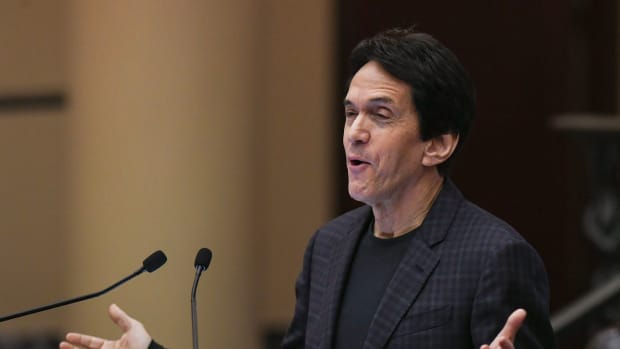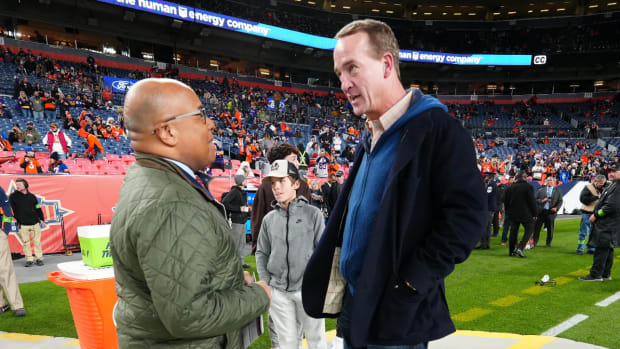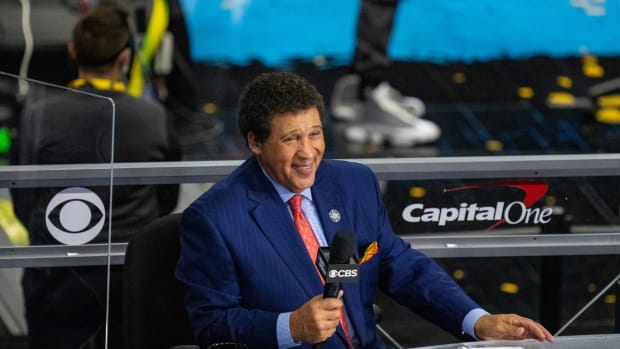Why the NFL's Ratings Saw a Steep Decline in 2017
There is no sugarcoating the news for the National Football League when it comes to viewership: The numbers are heading in the wrong direction—and quickly.
You have reached your limit of 4 premium articles
Register your email to get 1 more
Per Austin Karp of Sports Business Daily, viewership for NBC’s Sunday Night Football, ESPN’s Monday Night Football and the shared Thursday Night Football package (between NBC, CBS, NFL Network and Amazon) all declined for the second straight season. NBC averaged 18.2 million viewers for its set of games, the package's lowest figure since 2008, when it averaged 16.6 million viewers. MNF trended up for most of the season before a couple of late-season dogs sent the series to its lowest audience ever. TNF averaged 10.9 million viewers, including 13 Thursday night games, one Sunday morning game, two Saturday afternoons, one Saturday night and a Christmas Day game (on a Monday afternoon). Karp said the TNF mark was the lowest since broadcast networks became partners in the package in 2014.
The raw numbers (avg. viewership):
NBC’s Sunday Night Football
2017: 18.175 million
2016: 20.323 million
2015: 22.522 million
ESPN’s Monday Night Football
2017: 10.757 million
2016: 11.390 million
2015: 12.896 million
Thursday Night Football (NBC/CBS/NFL Network)
2017: 10.937 million
2016: 12.438 million
2015: 12.425 million
Ad Age’s Anthony Crupi, who along with Karp is one of the experts in this space, reported that the NFL’s regular-season ratings overall were down about 9% versus its audience a year ago. Crupi said what jumped out at him was the disappearance of NFL blockbuster games that pull a 15.0 household rating. Only one game, Crupi said, broke the 15.0 rating barrier in 2017—the Dec. 17 Patriots-Steelers matchup on CBS’ late national window (15.2.) Last season there were three 15-plus games: Giants-Cowboys (15.5), Cowboys-Packers (15.8) and Cowboys-Steelers (16.4). All three aired in Fox's late national window. Crupi said there were 13 15.0-plus games across the networks in 2015.
The positive news—and there is positive news: Sunday Night Football was the most-watched show in primetime in viewership and trounced the top scripted series (CBS’ Big Bang Theory) by four million viewers. SNF had the highest adult 18-49 rating (6.1) among any show for the 10th consecutive fall season and accounted for eight of the 10 most-watched primetime telecasts between Sept. 7, 2017 and Dec. 25, 2017 (Fox’s World Series games were the other two). ESPN’s Monday Night Football was the No. 1 show on cable TV (ahead of The Walking Dead and HBO's Game of Thrones). And Crupi pointed out in a recent story that, according to Nielsen live-plus-same-day data, NFL games accounted for 37 of the year's top 50 broadcasts, or nearly three-quarters (74%) of the most-watched programs on TV. That marked a 32% increase compared to 2016, when the NFL had 28 of the top 50 most-watched programs, and was flat versus the 37 top broadcasts the NFL had in the previous year.
So what should readers make of these numbers? I asked Karp and Crupi for some expanded thoughts.
Crupi:
“This season's ratings slide became the focus of an almost creepy fascination, thanks in large part to the noisy condemnation of the White House, which was amplified by the screaming heads at the President's favorite news outlet. In short order, the nation's armchair quarterbacks seized upon the dopey ‘NFL is weak and out of control’ narrative, and given that the sum of the general public's knowledge about the TV business can be inscribed on the lip of a Zima bottle with a blunted crayon, most of the criticism levied against the league's ratings prowess fell wide of the mark.
None of which is to say that the NFL didn't take another ratings hit, although it is perhaps worth noting that the league's 9% decline in its overall deliveries matches the 9% season-to-date drop in broadcast prime. Through Week 13 of the 2017–18 TV season, the Big Four nets [ABC, CBS, NBC, Fox] were collectively averaging a meager 6.3 million total viewers per night, which marks a shortfall of around 650,000 viewers when compared to the year-ago period. Meanwhile, the national games that kick off at 4:20 p.m. ET on CBS and Fox scared up three-and-a-half times the number of viewers who tuned into the broadcast nets between 8 p.m. and 11 p.m.
While I'd sooner eat off the floor of a subway car than re-litigate the Colin Kaepernick tiff, it's worth exploring some of the root causes behind football's latest ratings shakeup. Truncated by one game, NBC's Sunday Night Football closed out the season down 11% in total viewers and off 10% in household ratings, although a rapid late-season deceleration would appear to have contributed to the package's double-digit declines. (Through Week 11, SNF was down 6% in both metrics.) Two things sort of jump out at me about SNF: 1) the average margin of victory for the 18 broadcasts was 12.9 points per game, the highest since 2014, and 10 of those games were decided by two touchdowns or better; and 2) over the course of the season, NBC and the NFL didn't exercise the flex scheduling option even once. The latter speaks to the fact that there weren't an awful lot of more attractive options on the table; as much as the Dec. 17 Dallas-Oakland game was effectively meaningless, CBS had protected the afternoon Pats-Steelers showdown against the flex. (Unsurprisingly, the reprise of last season's AFC Championship game was CBS's top ‘ask' when the NFL was putting the 2017 schedule together. As such, the network wasn't about to punt it over to NBC prime.) For all that, the lack of any flex action was a bit jarring; last season, two far more attractive games were slotted into SNF from the Sunday afternoon schedule, while 2015 gave rise to no fewer than four prime-time flexes.
Also not helping matters: Aaron Rodgers' collarbone, an historically lousy New York Giants squad and a Dallas offense that may charitably be characterized as inept. While the underperforming Cowboys remained the NFL's most-watched, highest-rated franchise in national TV windows with an average draw of 21.6 million viewers and an 11.9 household rating, those numbers were down 11% versus last season's gaudy deliveries (24.4 million/13.4 HH). Green Bay's run of bum luck helped contribute to a 9% year-over-year decline for the Pack, while the unwatchable G-Men saw their national ratings fall 11%.
The crummy showings by many of the teams that were expected to make deep runs into January—looking at you, Raiders—is likely to eat into the playoff ratings as well. The Cowboys, Packers, Giants, 49ers and the Redskins aren't heading to the postseason for the first time since 1964, and in September those first three teams were Vegas betting favorites to make noise in the postseason.
For much of the year, ESPN's Monday Night Football package had carved out slight ratings gains when compared to the 2016 campaign, but a late run of largely meaningless games and tough year-over-year comps contributed to a seasonal 6% decline in viewers and HH ratings. At the risk of engaging in unchecked hyperbole, ESPN's schedule was the usual run of uninspired matchups (Dolphins-Panthers, Texans-Ravens) and hot garbage (Lions-Giants, Colts-Titans), which only served to make the network's annual $2 billion payment to the Shield all the more of a head-scratcher.
You'll never make me care about the trilateral Thursday Night Football package, but give credit to CBS for hosting the season's most stable NFL package. The Tiffany Network's suite of five early-season Thursday games slipped just 4% from a year ago, perhaps because none of the 10 teams on its roster had been eliminated when the schedule pivoted to NBC. TNF is crummy, dangerous football, but because it still stands as the No. 2-rated prime-time broadcast program (trailing only SNF), we'll never be shut of it.
As much as the Sunday afternoon games tend to get overshadowed by Sunday Night Football, the 4:20 p.m. games on Fox and CBS are far and away the most-watched, higher-rated broadcasts on all of TV. The big Sunday afternoon window fell 9% year-over-year, drawing 22.2 million viewers and a 12.3 household rating while commanding an average unit cost north of $715,000 per 30-second ad. Given the vicissitudes of TV's supply-and-demand market, commercial inventory fetches even higher pricing when ratings are down and demand is flat to up; as such, the stewards of this powerhouse package aren't exactly gnashing their teeth and rending their garments over the ratings drop. (Which is not to say that yet another season of high-digit declines in 2018 wouldn't make the ad sales people a little anxious.) Meanwhile, the Sunday afternoon regional games were off 11%, and while anecdotal evidence would suggest that the magnificent, commercial-free NFL RedZone Channel may have played a part in the erosion, what little Nielsen data re: Scott Hanson's ratings are available argue otherwise.
Thus, my three factors in NFL ratings declines:
1) Nobody knows what a catch is.
2) Supersaturation.
3) [Insert personal bugaboo here].”
Karp:
“I’m looking at NFL primetime viewership through two lenses:
• How is the NFL doing against itself?
• How is the NFL as TV entertainment property?
Two years of ratings drops isn’t a federal crisis, but definitely cause for reflection and analysis. That’s for any TV property. Everything just gets magnified when it’s the NFL. This has been said a million times, but the primetime TV habits of old no longer apply. What does that mean for 2018? For Sunday Night Football, two years of sharp drops is a concern for the league and NBC. I’m an optimist and I want to say ratings can rebound next season, but I’m not sure. A lot of that depends on certain teams rebounding and on certain big-name players being healthy. It can definitely happen, but by no means is Sunday Night Football guaranteed to go up 20% to where it was two seasons ago. I believe a certain level of football fatigue has settled in by Sunday nights (college + NFL), and that doesn’t help. This is beating a dead horse already, but people have other entertainment options at their fingertips. But at least NBC has flex options for SNF. Monday Night Football was actually tracking for a gain for most of this season, but the back half of the schedule just didn’t do them any favors. And they were only down 6%. Not great, but not the apocalypse, either. Can they rebound in 2018? Maybe. They need some better matchups, and without flex scheduling for ESPN, that’s tough later in the season.
This is always a zero-sum game with the networks and good matchups. Putting something like Giants-Cowboys on ESPN means Fox or NBC doesn’t get that game (which ironically wasn’t a big deal this past season, but normally is). But a gain for ESPN also is not guaranteed. I also think Thursday night is in a tough spot to rebound relative to what it was a few seasons ago. But I don’t think that’s a big deal for the league. It uses this package as a laboratory for experiment. If we’re talking advertising dollars, you have to look at the NFL against other properties. A bad NFL audience still gets more than what Netflix drew for the first three days after the release of Bright. Sunday night is still king in primetime, by a LOT. Thursday Night Football is in the top five now in primetime. Advertisers have to put their dollars somewhere. The NFL is still a solid bet for those brands, wherever and whenever it airs.”
